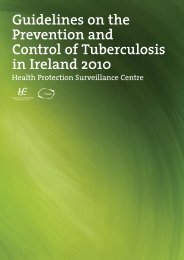The Management of Viral Haemorrhagic Fevers in Ireland - Health ...
The Management of Viral Haemorrhagic Fevers in Ireland - Health ...
The Management of Viral Haemorrhagic Fevers in Ireland - Health ...
You also want an ePaper? Increase the reach of your titles
YUMPU automatically turns print PDFs into web optimized ePapers that Google loves.
should be identified <strong>in</strong> a bid to avoid unnecessary duplication. However, if any doubt exists, the crew mustensure that NAS emergency resuscitative equipment is carried as a m<strong>in</strong>imum. This equipment should be <strong>in</strong> asealed bag and left sealed unless required.<strong>The</strong> crew must then don a Tyvex suit (with feet), worn over a boiler suit, and fastened up to the neck, ensur<strong>in</strong>gthat their hair is tucked <strong>in</strong>side the hood <strong>of</strong> the suit. All articles <strong>of</strong> cloth<strong>in</strong>g, together with personal items, shouldbe left with the Operations Resource Manager <strong>in</strong> an appropriate storage conta<strong>in</strong>er. Once f<strong>in</strong>al checks have beencompleted, the crew should then plan their routes <strong>of</strong> travel for both journeys.Key Po<strong>in</strong>ts for ambulance crew and staff to remember before transferr<strong>in</strong>g a patient at High Risk <strong>of</strong>, orConfirmed as hav<strong>in</strong>g, VHF:Check:Ensure:‣ that you have received full <strong>in</strong>formation about the condition <strong>of</strong> the patient and thepossibility <strong>of</strong> sudden deterioration dur<strong>in</strong>g the journey, and that you give this <strong>in</strong>formation tothe cl<strong>in</strong>ical team;‣ the specific arrangements for the journey, <strong>in</strong>clud<strong>in</strong>g possible escort for long road journeys;‣ that you are aware <strong>of</strong> arrangements <strong>in</strong> case <strong>of</strong> an emergency (cardiac arrest, breakdownetc).‣ that you are fully familiar with the transportation procedures prepared by the NationalAmbulance Service (NAS);‣ that you ma<strong>in</strong>ta<strong>in</strong> close communication with the receiv<strong>in</strong>g cl<strong>in</strong>ical team at the NIU at alltimes;‣ that suitable PPE is worn by all members <strong>of</strong> the ambulance crew and staff at all times;‣ that under no circumstances should direct oral resuscitation be carried out – a bag andmask should be used to resuscitate patients;‣ that no members <strong>of</strong> staff who have been <strong>in</strong> contact with the patient leave the ambulanceen route.6.3 At the pick-up locationPrior to enter<strong>in</strong>g the patient’s room, the crew will don the rema<strong>in</strong><strong>in</strong>g PPE: disposable gloves, FFP3 maskand their safety eyewear. Only those items <strong>of</strong> equipment required to aid the removal <strong>of</strong> the patient to theambulance will be brought <strong>in</strong>to the patient’s room. If the patient has respiratory symptoms, they should wear asurgical mask if tolerated.Once <strong>in</strong> the patient’s room, care must be taken to treat any spillage <strong>of</strong> blood or body fluids immediately asoutl<strong>in</strong>ed <strong>in</strong> Chapter 3. All items <strong>of</strong> ambulance equipment should be removed from the location. This <strong>in</strong>cludesthe removal <strong>of</strong> any materials that have been used for clean<strong>in</strong>g spillages etc., which must be str<strong>in</strong>gentlycollected as Category A healthcare risk waste.6. Transport <strong>of</strong> Infected Patients <strong>The</strong> <strong>Management</strong> <strong>of</strong> <strong>Viral</strong> <strong>Haemorrhagic</strong> <strong>Fevers</strong> <strong>in</strong> <strong>Ireland</strong>/HPSC 2012<strong>The</strong> ambulance crew should attempt to keep well-wishers at a distance whilst transferr<strong>in</strong>g the patient to theambulance, particularly where physical contact is anticipated. Relatives/friends are not to be transported <strong>in</strong>the ambulance to the NIU or any receiv<strong>in</strong>g hospital. On leav<strong>in</strong>g the patient’s room, the crew will report to theAmbulance Command and Control Centre and provide an estimated time <strong>of</strong> arrival (ETA) to the designatedhospital. Ambulance Command and Control will alert the NIU that the crew have left scene and are en-routeand confirm their ETA.- 60 -
















